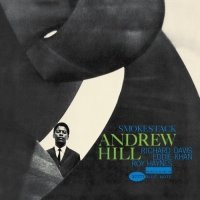Andrew Hill - Smoke Stack (1963)
 Don Heckman states quite clearly that Smoke Stack was Andrew Hill's second visit to Rudy van Gelder's Studios for Blue Note. What could go without saying, given the pictures of previous issues that accompanied Heckman's notes on the back of the original LP, was that it was the fourth Hill album to be issued. Those numbers suggest how challenging the music included here sounded -then and now- as well as to the priority the pianist assigned to this music among the voluminous body of original compositions he brought to the label.
Don Heckman states quite clearly that Smoke Stack was Andrew Hill's second visit to Rudy van Gelder's Studios for Blue Note. What could go without saying, given the pictures of previous issues that accompanied Heckman's notes on the back of the original LP, was that it was the fourth Hill album to be issued. Those numbers suggest how challenging the music included here sounded -then and now- as well as to the priority the pianist assigned to this music among the voluminous body of original compositions he brought to the label.Producer Alfred Lion had clearly been excited by Hill, hearing in his playing and composing a deep and original concept akin to those of previous Blue Note discoveries, Thelonious Monk and Herbie Nichols. Yet Lion must have sensed that this particular quartet playing these seven originals would pose a challenge that listeners might feel unprepared to accept on the basis of his only previous effort, the iconoclastic though far more conventional quartet session Black Fire with Davis, Haynes and Joe Henderson, taped only a month earlier. So Hill was brought back a mere month after Smoke Stack for Judgement, with the same rhythm section plus Bubby Hutcherson. Perhaps the magnificence of Hill's next effort, the sextet Point of Departure from March 1964, would have delayed any of the pianist's unreleased music. The fact that Hill chose to document to the present configuration of piano, two basses, and drums so quickly in his recording career confirms the importance he placed in both the unusual setting and the music he crafted for it.
Employing two basses in a rhythm section had been used on previous occasions, most notably by John Coltrane and Ornette Coleman, although Hill's approach to the challenge differed in that he did not really hear his bassists as two equal voices. This is why Smoke Stack can not be fully understood if viewed as one of three Hill albums with the Davis/Haynes rhythm section. With the exception of "Verne", where Eddie Khan lays out, Davis is in truth more the second feature voice, one that -given the tonal and textural mesh of piano and bass- could assume a more constant and interactive role in a quartet setting than Henderson's tenor of Hutcherson's vibes.
The wizardly Davis fills this part to perfection, stressing the ambiguous edges of what at this stage remained odd but still defined structures. Khan is the accompanist here, and goes about his business in a self-effacing way (one can only wonder what magic might have arisen if a third Chicagoan, Wilbur Ware, had joined Hill and Davis in this effort). Khan met a number of musical challenges in recordings of the period with Henderson, Freddie Hubbard, Jackie McLean, and Max Roach, and shows his own exploratory bent in solos on "30 Pier Avenue" and "Ode to Von".
Roy Haynes is the perfect for the combustible control that this music evokes. He is constantly elaborating the beat without losing it, and his own tonal/textural mesh of empathic snare, tom-tom and cymbal figures creates a brilliant balance of its own with the perpetual thickening and thinning, rising and falling of Hill's piano. The piano/drum exchanges on both takes of "Ode to Von" are among the best examples of a piano/drum partnership that deserves reviving.
Adding to the unusual sound of the two-bass quartet is the unpredictable nature of Hill's compositions. When Mosaic Records issued a box-set of Hill's work in 1995, producer Michael Cuscuna had the foresight to enlist Bob Belden in helping to decipher Hill's schemes. "Belden can transcribe most music in real time" Cuscuna reported, and what Belden discovered in this instance was a 50-bar title tune and a 22-bar "Not So", among other challenging if less asymmetric offerings. Given the way Hill develops thematic kernels, both within the written line and in his improvisations, a sufrace coherence is sustained that takes the listener along the unusual choruses in surprising comfort.
Each of the four alternate takes (which first appeared in 1995) was considered for release on the original LP. The alternate "Smoke Stack" opened the session and contains a shorter piano solo. The master of "Ode to Von" (for Von Freeman, still unknown outside Chicago at the time) preceded the alternate and receives a more combustible performance, while the master of "The Day After" came first and seems more settled. The influence of Monk is most clearly felt on the master of "Not So", cut after the alternate. Finally, the trio piece "Verne" is named for Hill's first wife, the late organist Laverne Gillette.
No comments:
Post a Comment